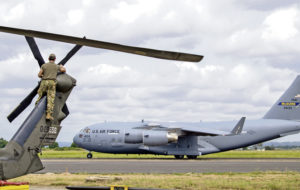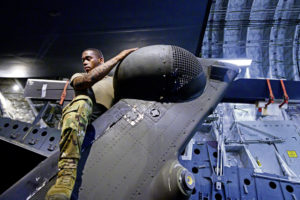MOMBASA INTERNATIONAL AIRPORT, Kenya — Aerial porters from the 435th Contingency Response Squadron moved cargo and personnel during a deployment of the 82nd Combat Aviation Brigade in early March.
In an overall effort to support global air mobility, the 435th CRS “Port Dawgs” played an integral role in countering violent extremist organizations by ensuring the 82nd CAB arrived at the Kenyan Defense Force Installation, Camp Simba, with strategic airlift assets and personnel.
“The 82nd CAB rapidly deploys in support of the Global Response Force to conduct decisive aviation operations worldwide to enable assault, air movement, attack, reconnaissance and medical evacuation capabilities,” said U.S. Air Force Maj. Brad Seehawer, 435th CRS operations officer.

The U.S. Transportation Command directed the movement of the 82nd CAB’s UH-60 Black Hawks aboard C-17 Globemaster III aircraft into Mombasa International Airport, Kenya. With the help of the Port Dawgs, the C-130J Super Hercules aircraft were then delivered to their final destination.
“The aerial porters were an essential part of the 82nd CAB’s support of the east Africa area of operation because the deployment was all about the speed of response,” Seehawer said.
The 435th CRS Port Dawgs offloaded, prepared and loaded more than 100 tons of cargo and approximately 80 passengers from four C-17 Globemaster III aircraft to 10 C-130J Super Hercules aircraft.
“The physical process of downloading cargo from the C-17 and uploading to the C-130J is accomplished in a matter of hours,” Seehawer said. “The difficult part is staging each individual C-130J’s cargo and passenger loads to ensure full aircraft utilization, while maintaining safety of flight for the passengers and crew.”
It took approximately two weeks for the 435th CRS aerial porters to finalize this strategic move of airlift assets.
“The time-consuming part of the mission was waiting for the C-130J Super Hercules to travel to its destination, download the cargo, then fly back to Mombasa to pick up more, repeating this over several days per C-17 Globemaster III load,” Seehawer said.

For short notice support operations throughout Europe and Africa, the Port Dawgs have to be ready.
“Africa is unique in its sheer size, which adds to the complexity of large logistics movements like this,” Seehawer said. “The 435th CRS is unique as we have the largest number of Port Dawgs of any unit in U.S. Air Forces in Europe – Air Forces Africa, which allows us to support a wide variety of mobility taskings across the area of responsibility.”
Being able to operate out of the Mombasa International Airport aided in mission success due to an established infrastructure which is required in order to accommodate large cargo operations.
“The 435th CRS is trained and ready to operate in a variety of austere environments if called upon,” Seehawer said. “If the host nation is willing to provide us with an airfield to operate from, it increases the agility with which we can respond, something that’s desired for a movement like this.”
The 435th CRS aerial porters are among the best trained, equipped and most experienced porters in the region.
When the Port Dawgs weren’t loading planes, they were setting up sleeping quarters for the aircrew and passengers. They also restocked the water and meal supply.
“It was busy and hot, but everyone was in good spirits and having a good time,” said Master Sgt. Michael Bailey, 435th CRS mobile aerial port flight chief and team lead. “This is the kind of stuff we love to do. Our porters don’t just sit around while they’re waiting for the next aircraft to load; they’re fully participating members of the team.”
The movement of the 82nd CAB personnel and equipment wouldn’t have been as quick or efficient without the 435th CRS aerial porters facilitating ground operations.
“Missions like these build leadership experience and needed proficiency which allows the squadron to open an airbase anywhere in Europe or Africa,” Seehawer said.


